Urbanisation and climate action: lessons for the Asia-Pacific region

A blog written by Dr Andrew Sudmant, Research Fellow in the School of Earth and Environment
As cities in the Asia-Pacific Region absorb an additional billion people over the next twenty-five years, it is no exaggeration to say that the processes of urbanisation that take place will significantly determine the path of the global climate. To what extent can urban growth, sustainable development, and climate action, all be achieved simultaneously?
As stakeholders meet this week for Asia-Pacific Climate Week they can turn to a growing body of research from academics at the University of Leeds.
Lower carbon means better growth
As renewable energy costs continue to plunge and new technologies are developed, the economic case for climate action continues to grow stronger. Approximately one-quarter of business-as-usual emissions from urban areas – including from cities that are rapidly growing – can be mitigated in the next 5-10 years with the implementation of currently available actions that generate financial returns for investors and policymakers.

© grafixme / Adobe Stock
The scale of wider benefits, however, from cleaner air, to new employment and reduced energy poverty, can be orders of magnitude more significant and in amongst electric cars and the latest breakthroughs in solar modules, some of the measures that achieve the largest impact, are well known, even relatively prosaic. For example, increasing rates of cycling in Shanghai would not only achieve substantial reductions in greenhouse gas emissions, but would reduce expenditure on energy, improve air quality, and support a shift to more liveable neighbourhoods.
Processes of urban governance are key
Even as the economic case for low carbon action grows, and as social and political pressure increases, a persistent gap exists between the level of climate action we need, and the levels of action we are taking. Part of this gap is the result of a lack of on the ground, place-based support for low carbon action. Low carbon opportunities can be highly place and context specific. Indeed, a divide is developing between cities that produce carbon-intensive goods and services, and places that are sites of consumption of these goods and services, with each of these places offering different opportunities for climate action.
Realising action is also challenged by underdeveloped processes of urban governance. Coordination, both vertically between levels of government, and horizontally between government and diverse sets of public and private urban stakeholders, is critical to support the exchange of knowledge, the coordination of action, and to direct capacities. The Changning Low Carbon Office in Shanghai provides an example that can be learned from. By developing resources such as China’s first online platform for monitoring the energy performance of buildings, the Changning Office has supported the retrofit of more than half the regions commercial and public space over the last decade.
New technologies are more likely to complement, than replace, existing forms and processes of action
If in the 2000s we wanted flying cars and instead got 140 characters, a view of any major publication in the last year would suggest the technological revolution had merely been delayed. Floating wind turbines, autonomous vehicles, solid state batteries, full-spectrum solar panels, 5G smart grids, personal jetpacks, what should we make of the increasing number of technologies that crowd headlines, and in some cases, the public imagination?

© Mazur Travel / Adobe Stock
Where such technologies are more than toys for the wealthy (as with personal jetpacks), finding ways to leverage innovations without delaying action, or privileging what is new and exciting (autonomous cars) over what is established and effective (walking and cycling), is the challenge facing policymakers. This is especially the case for innovations that have the potential to support decision making. For example, we found several ways the use of Google Maps data in Hubballi-Dharwad, India, could lead to unintended consequences for urban transport policymaking if it is not paired with on-the-ground analysis of transport conditions.
Equity enables action
It is a cruel feature of climate change that those who will be affected most by a changing climate and those who could be most negatively affected by action, are those who can afford it least. Making wider socioeconomic considerations central to programs of action, however, is found to be critical for developing long-term, sustaining programs of action. In Kolkata, India, for example, realising significant opportunities for the mitigation of emissions from the waste sector is supported by working with communities that depend on waste-picking. Similarly, working with the informal transport sector can be the key to unlocking both social environmental benefits from urban mobility.
Drawing on these and wider lessons from research will be central to informing the strategies and approaches policymakers take to COP26 in November, and to action taken beyond. As such, experts across the University of Leeds will continue to work with collaborators in the Asia Pacific region, forging the way to a more sustainable future.
Main image © F11photo / Adobe Stock
